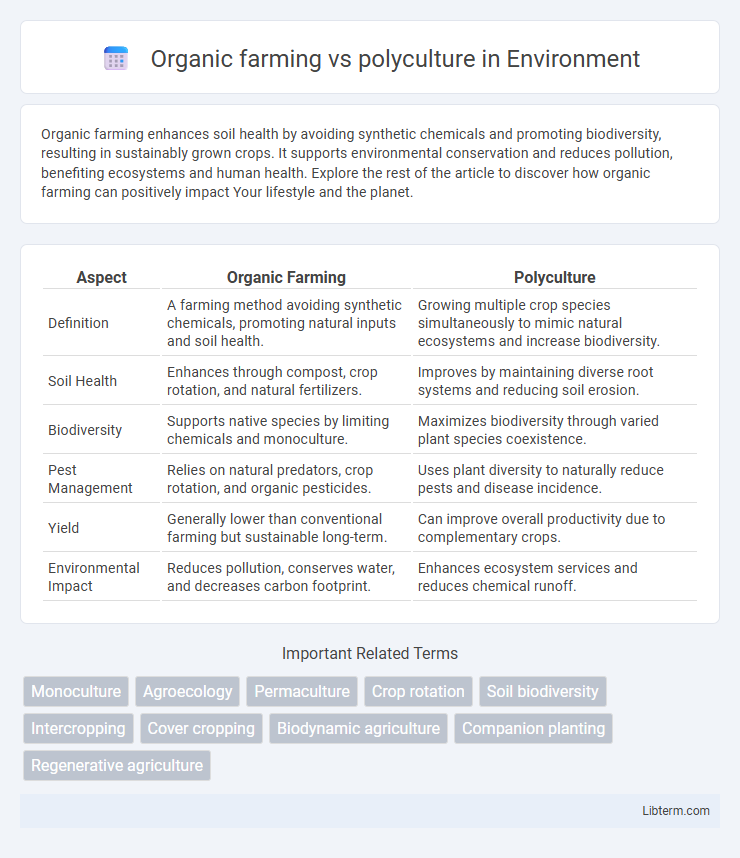Organic farming enhances soil health by avoiding synthetic chemicals and promoting biodiversity, resulting in sustainably grown crops. It supports environmental conservation and reduces pollution, benefiting ecosystems and human health. Explore the rest of the article to discover how organic farming can positively impact Your lifestyle and the planet.
Table of Comparison
| Aspect | Organic Farming | Polyculture |
|---|---|---|
| Definition | A farming method avoiding synthetic chemicals, promoting natural inputs and soil health. | Growing multiple crop species simultaneously to mimic natural ecosystems and increase biodiversity. |
| Soil Health | Enhances through compost, crop rotation, and natural fertilizers. | Improves by maintaining diverse root systems and reducing soil erosion. |
| Biodiversity | Supports native species by limiting chemicals and monoculture. | Maximizes biodiversity through varied plant species coexistence. |
| Pest Management | Relies on natural predators, crop rotation, and organic pesticides. | Uses plant diversity to naturally reduce pests and disease incidence. |
| Yield | Generally lower than conventional farming but sustainable long-term. | Can improve overall productivity due to complementary crops. |
| Environmental Impact | Reduces pollution, conserves water, and decreases carbon footprint. | Enhances ecosystem services and reduces chemical runoff. |
Introduction to Organic Farming and Polyculture
Organic farming emphasizes the use of natural fertilizers, crop rotation, and biological pest control to maintain soil health and reduce environmental impact. Polyculture involves cultivating multiple crop species simultaneously, enhancing biodiversity and resilience against pests and diseases. Both methods promote sustainable agriculture by improving ecosystem balance and reducing dependence on synthetic inputs.
Key Principles of Organic Farming
Organic farming emphasizes soil health, biodiversity, and natural pest control through practices such as crop rotation, composting, and avoiding synthetic chemicals. It prioritizes maintaining ecological balance and enhancing the fertility of the land by using organic inputs and promoting biological interactions. Unlike polyculture, which involves growing multiple crops simultaneously to maximize land use and reduce pests, organic farming integrates a holistic approach focused on sustainable and chemical-free agriculture.
Understanding Polyculture Systems
Polyculture systems integrate multiple crop species or livestock types in the same space, enhancing biodiversity and resource use efficiency compared to organic farming, which primarily avoids synthetic inputs but may focus on monoculture practices. Understanding polyculture involves recognizing the ecological interactions that improve pest control, soil health, and resilience to environmental stressors through complementary species relationships. Research indicates polyculture can increase overall yield stability and reduce dependence on external agrochemicals, aligning with sustainable agriculture goals beyond organic certification standards.
Soil Health: Organic vs Polyculture Approaches
Organic farming enhances soil health through the use of natural fertilizers like compost and green manure, promoting microbial diversity and nutrient cycling. Polyculture systems improve soil structure and fertility by integrating multiple crops that complement each other's nutrient needs and reduce pest outbreaks. Both methods prioritize reducing chemical inputs, but polyculture offers increased resilience by mimicking natural ecosystems and maintaining continuous ground cover.
Pest and Disease Management Strategies
Organic farming employs biological controls, crop rotations, and natural pesticides to enhance pest and disease resistance while maintaining soil fertility. Polyculture integrates diverse plant species, creating a balanced ecosystem that naturally disrupts pest life cycles and reduces disease outbreaks. Both approaches emphasize ecological balance, minimizing reliance on synthetic chemicals for sustainable pest and disease management.
Crop Yield and Productivity Comparison
Organic farming relies on natural inputs and crop rotations to maintain soil fertility, often resulting in lower yields compared to conventional methods but enhanced long-term soil health. Polyculture systems grow multiple crop species simultaneously, which can improve resource utilization and resilience, often leading to higher or more stable overall productivity than monoculture organic farms. Studies indicate polyculture can increase total yield by 10-30% compared to single-crop organic farms due to diverse nutrient cycling and pest control benefits.
Biodiversity Benefits in Both Practices
Organic farming enhances biodiversity by avoiding synthetic pesticides and fertilizers, promoting a healthier ecosystem with diverse soil microorganisms, beneficial insects, and crop varieties. Polyculture increases biodiversity through the simultaneous cultivation of multiple crop species, which reduces pest outbreaks and improves habitat complexity for wildlife. Both practices contribute to ecological balance and resilience, supporting pollinators, natural pest predators, and overall agroecosystem health.
Environmental Impact: Organic vs Polyculture
Organic farming minimizes chemical inputs by relying on natural fertilizers and pest control, enhancing soil health and reducing pollution. Polyculture promotes biodiversity through the cultivation of multiple crop species, improving ecosystem resilience and pest regulation. Both methods reduce environmental impact compared to conventional monoculture but differ in approach: organic farming emphasizes chemical-free practices, while polyculture focuses on ecological diversity.
Economic Sustainability and Profitability
Organic farming enhances economic sustainability by reducing dependency on synthetic inputs, thereby lowering input costs while tapping into premium markets for organic produce, which often yields higher profit margins. Polyculture diversifies income streams through multiple crop and livestock outputs, mitigating market risks and improving soil health, leading to sustained productivity and long-term profitability. Both systems promote resilience against price volatility, but organic farming's market-driven premiums and polyculture's risk diversification offer complementary pathways to economic sustainability and profitability.
Future Trends and Innovations in Sustainable Farming
Future trends in sustainable farming emphasize the integration of organic farming principles with polyculture systems to enhance biodiversity, soil health, and crop resilience. Innovations such as precision agriculture technologies, AI-driven crop monitoring, and biofertilizers are optimizing nutrient cycles and pest management in both organic and polyculture farms. Emerging practices like agroforestry and regenerative agriculture further complement these methods, boosting carbon sequestration and long-term ecosystem sustainability.
Organic farming Infographic

 libterm.com
libterm.com